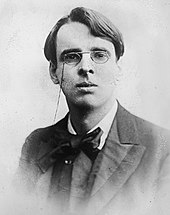The wild swans on cool
Die Wild Swans auf Coole (in the original: The Wild Swans at Coole ) is a poem by the Irish poet William Butler Yeats , which first appeared in the Little Review in 1917 , and was the title poem of the volume of poetry The same year (as well as 1919) wild swans on cool .
Both, the volume of poetry and the individual work, are considered to be one of the poet's strongest works and contributed significantly to the fact that he was awarded the Nobel Prize for Literature in 1923 .
Transfers into German
There are several translations into German, some of which were done by amateur translators. The Luchterhand Literaturverlag published in 2005 in the total expenditure for work Yeats in German. The translator of this poem was Christa Schuenke .
Emergence
The wild swans on Coole was created between 1916 and the spring of 1917. Yeats wrote (at least parts of) most likely in Coole Park during a visit to Isabella Augusta Gregory , known as Lady Gregory . Yeats dedicated the poem to Robert Gregory, the son of Lady Gregory, who died in the First World War . Robert Gregory was also an integral part of the second poem in the volume, In Memory of Major Robert Gregory .
structure
The poem consists of five stanzas of six verses each . In the original, the work is composed in regular iambs . The rhyme scheme is[xaxabb].
content
Daniel Tobin, a literary scholar, wrote that Yeats was melancholy and unhappy. Reflecting on the love repudiation of Maud Gonne and her daughter Iseult and the Irish rebellion against the British, Tobin further writes that the poem is driven by the poet's search for lasting beauty in a changing world where beauty is mortal and ephemeral.
Web links
Individual evidence
- ↑ Tobin, Daniel E. “Yeats's Personal Utterance in 'The Wild Swans at Coole.'” Yeats Eliot Review, (11: 3), Summer 1992, 57-63.

